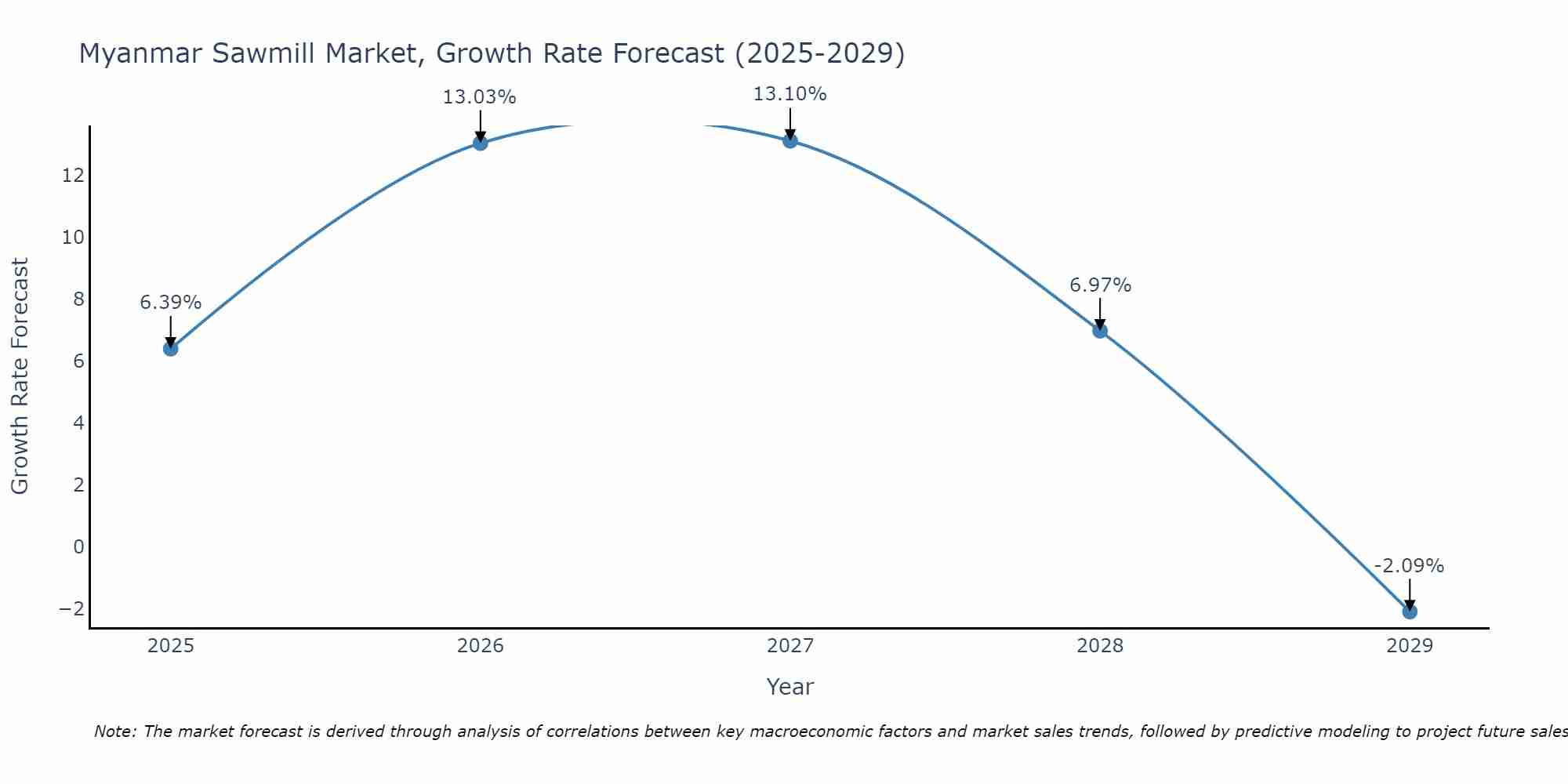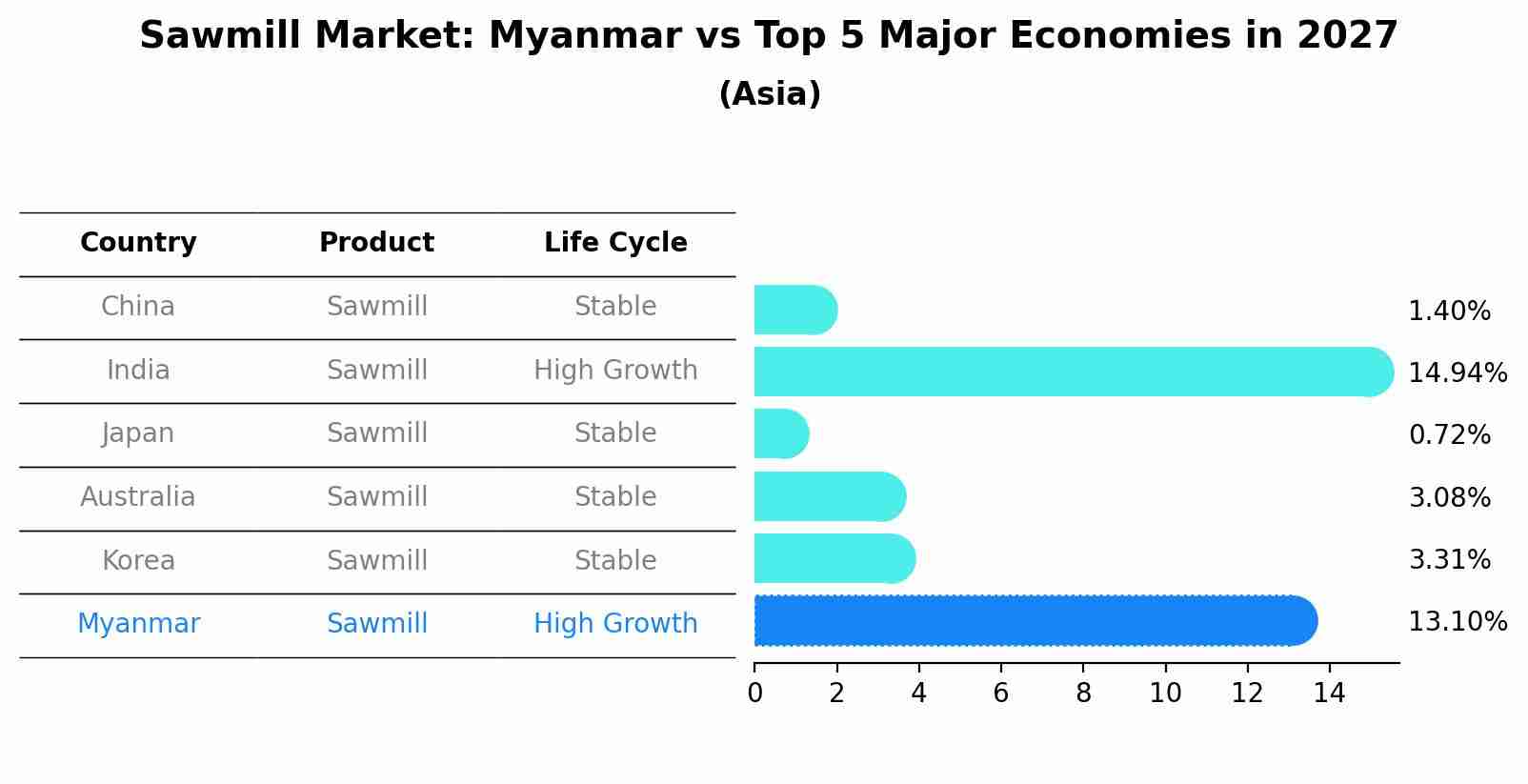Myanmar Sawmill Market (2025-2031) | Analysis, Value, Growth, Share, Outlook, Industry, Trends, Companies, Forecast, Size & Revenue
| Product Code: ETC034974 | Publication Date: Oct 2020 | Updated Date: Jun 2025 | Product Type: Report | |
| Publisher: 6Wresearch | Author: Shubham Deep | No. of Pages: 70 | No. of Figures: 35 | No. of Tables: 5 |
Myanmar Sawmill Market Size Growth Rate
The Myanmar Sawmill Market is projected to witness mixed growth rate patterns during 2025 to 2029. The growth rate begins at 6.39% in 2025, climbs to a high of 13.10% in 2027, and moderates to -2.09% by 2029.

Sawmill Market: Myanmar vs Top 5 Major Economies in 2027 (Asia)
The Sawmill market in Myanmar is projected to grow at a high growth rate of 13.10% by 2027, highlighting the country's increasing focus on advanced technologies within the Asia region, where China holds the dominant position, followed closely by India, Japan, Australia and South Korea, shaping overall regional demand.

Myanmar Sawmill Market Overview
The Myanmar sawmill market is currently experiencing growth driven by increasing demand for wood products in construction and furniture industries. The market is characterized by a mix of traditional and modern sawmills, with a shift towards more efficient and environmentally sustainable practices. Key players in the market include both large-scale industrial sawmills and small local operators. Challenges in the market include regulatory issues related to logging and timber trade, as well as competition from imported wood products. Despite these challenges, the market offers opportunities for innovation and technology adoption to improve efficiency and sustainability in wood processing. Overall, the Myanmar sawmill market is poised for continued growth with the potential for further development and modernization in the coming years.
Myanmar Sawmill Market Trends
The Myanmar sawmill market is experiencing a shift towards sustainable practices and technology integration. With a growing awareness of environmental conservation, sawmill operators are increasingly adopting responsible forestry practices and seeking certification from organizations such as the Forest Stewardship Council. Additionally, there is a rising demand for more efficient and automated sawmill equipment to improve productivity and reduce waste. The market is also seeing a trend towards the use of alternative materials such as bamboo and engineered wood products to meet the growing demand for eco-friendly and durable construction materials. Overall, the Myanmar sawmill market is evolving towards sustainability and innovation to meet the demands of a changing market landscape.
Myanmar Sawmill Market Challenges
The Myanmar sawmill market faces several challenges, including illegal logging practices, lack of sustainable forestry management, limited access to modern technology and equipment, and inconsistent government regulations. Illegal logging not only contributes to deforestation and environmental degradation but also undermines the competitiveness of legal sawmill operators. The lack of sustainable forestry management practices hinders long-term viability and threatens the availability of raw materials. Limited access to modern technology and equipment constrains efficiency and productivity in the sawmill operations. Additionally, inconsistent government regulations create uncertainty for market players, leading to difficulties in planning and investment decisions. Addressing these challenges will be crucial for the sustainable development of the Myanmar sawmill market.
Myanmar Sawmill Market Investment Opportunities
Investment opportunities in the Myanmar sawmill market include the potential for modernizing existing sawmills to improve efficiency and output, as well as the establishment of new sawmills to meet the growing demand for timber products both domestically and internationally. Additionally, there is a growing focus on sustainable forestry practices in Myanmar, presenting opportunities for investments in eco-friendly technologies and processes within the sawmill industry. With the government`s efforts to promote foreign investment and improve infrastructure in the country, there is a favorable environment for investors looking to capitalize on the growing demand for timber products in Myanmar. It is important for investors to conduct thorough market research and due diligence to assess the regulatory landscape, environmental impact, and potential risks associated with investing in the Myanmar sawmill market.
Myanmar Sawmill Market Government Policy
The Myanmar government has implemented various policies related to the sawmill market to address environmental concerns and promote sustainable practices. The logging industry is regulated through a logging ban on hardwood species to prevent deforestation and protect the country`s forests. Additionally, the government has enforced restrictions on logging activities in certain regions to control illegal logging and promote sustainable forest management. Sawmill operators are required to obtain proper permits and adhere to strict guidelines to ensure compliance with environmental regulations. The government also aims to promote the use of legally sourced timber products and supports initiatives to increase transparency and accountability in the industry to combat illegal logging practices.
Myanmar Sawmill Market Future Outlook
The future outlook for the Myanmar Sawmill Market appears promising yet challenging. With the growing demand for timber products both domestically and internationally, driven by rapid urbanization and infrastructure development, there is a significant opportunity for growth in the industry. However, the market also faces obstacles such as regulatory restrictions on logging and sustainability concerns. To thrive in this environment, sawmill operators in Myanmar will need to adopt sustainable practices, invest in modern technology to improve efficiency, and adhere to stringent regulatory requirements. Collaboration with the government and international organizations to promote responsible forestry management practices will be crucial for the long-term success of the industry.
Key Highlights of the Report:
- Myanmar Sawmill Market Outlook
- Market Size of Myanmar Sawmill Market, 2024
- Forecast of Myanmar Sawmill Market, 2026
- Historical Data and Forecast of Myanmar Sawmill Revenues & Volume for the Period 2021 - 2031
- Myanmar Sawmill Market Trend Evolution
- Myanmar Sawmill Market Drivers and Challenges
- Myanmar Sawmill Price Trends
- Myanmar Sawmill Porter's Five Forces
- Myanmar Sawmill Industry Life Cycle
- Historical Data and Forecast of Myanmar Sawmill Market Revenues & Volume By Product Type for the Period 2021 - 2031
- Historical Data and Forecast of Myanmar Sawmill Market Revenues & Volume By Softwood Lumber for the Period 2021 - 2031
- Historical Data and Forecast of Myanmar Sawmill Market Revenues & Volume By Hardwood Lumber for the Period 2021 - 2031
- Historical Data and Forecast of Myanmar Sawmill Market Revenues & Volume By Application for the Period 2021 - 2031
- Historical Data and Forecast of Myanmar Sawmill Market Revenues & Volume By Construction for the Period 2021 - 2031
- Historical Data and Forecast of Myanmar Sawmill Market Revenues & Volume By Furniture for the Period 2021 - 2031
- Historical Data and Forecast of Myanmar Sawmill Market Revenues & Volume By Packaging and Joinery Industries for the Period 2021 - 2031
- Historical Data and Forecast of Myanmar Sawmill Market Revenues & Volume By Others for the Period 2021 - 2031
- Myanmar Sawmill Import Export Trade Statistics
- Market Opportunity Assessment By Product Type
- Market Opportunity Assessment By Application
- Myanmar Sawmill Top Companies Market Share
- Myanmar Sawmill Competitive Benchmarking By Technical and Operational Parameters
- Myanmar Sawmill Company Profiles
- Myanmar Sawmill Key Strategic Recommendations
Frequently Asked Questions About the Market Study (FAQs):
1 Executive Summary |
2 Introduction |
2.1 Key Highlights of the Report |
2.2 Report Description |
2.3 Market Scope & Segmentation |
2.4 Research Methodology |
2.5 Assumptions |
3 Myanmar Sawmill Market Overview |
3.1 Myanmar Country Macro Economic Indicators |
3.2 Myanmar Sawmill Market Revenues & Volume, 2019 & 2026F |
3.3 Myanmar Sawmill Market - Industry Life Cycle |
3.4 Myanmar Sawmill Market - Porter's Five Forces |
3.5 Myanmar Sawmill Market Revenues & Volume Share, By Product Type, 2019 & 2026F |
3.6 Myanmar Sawmill Market Revenues & Volume Share, By Application, 2019 & 2026F |
4 Myanmar Sawmill Market Dynamics |
4.1 Impact Analysis |
4.2 Market Drivers |
4.3 Market Restraints |
5 Myanmar Sawmill Market Trends |
6 Myanmar Sawmill Market, By Types |
6.1 Myanmar Sawmill Market, By Product Type |
6.1.1 Overview and Analysis |
6.1.2 Myanmar Sawmill Market Revenues & Volume, By Product Type, 2016 - 2026F |
6.1.3 Myanmar Sawmill Market Revenues & Volume, By Softwood Lumber, 2016 - 2026F |
6.1.4 Myanmar Sawmill Market Revenues & Volume, By Hardwood Lumber, 2016 - 2026F |
6.2 Myanmar Sawmill Market, By Application |
6.2.1 Overview and Analysis |
6.2.2 Myanmar Sawmill Market Revenues & Volume, By Construction, 2016 - 2026F |
6.2.3 Myanmar Sawmill Market Revenues & Volume, By Furniture, 2016 - 2026F |
6.2.4 Myanmar Sawmill Market Revenues & Volume, By Packaging and Joinery Industries, 2016 - 2026F |
6.2.5 Myanmar Sawmill Market Revenues & Volume, By Others, 2016 - 2026F |
7 Myanmar Sawmill Market Import-Export Trade Statistics |
7.1 Myanmar Sawmill Market Export to Major Countries |
7.2 Myanmar Sawmill Market Imports from Major Countries |
8 Myanmar Sawmill Market Key Performance Indicators |
9 Myanmar Sawmill Market - Opportunity Assessment |
9.1 Myanmar Sawmill Market Opportunity Assessment, By Product Type, 2019 & 2026F |
9.2 Myanmar Sawmill Market Opportunity Assessment, By Application, 2019 & 2026F |
10 Myanmar Sawmill Market - Competitive Landscape |
10.1 Myanmar Sawmill Market Revenue Share, By Companies, 2024 |
10.2 Myanmar Sawmill Market Competitive Benchmarking, By Operating and Technical Parameters |
11 Company Profiles |
12 Recommendations |
13 Disclaimer |
- Single User License$ 1,995
- Department License$ 2,400
- Site License$ 3,120
- Global License$ 3,795
Search
Thought Leadership and Analyst Meet
Our Clients
Related Reports
- Germany Breakfast Food Market (2026-2032) | Industry, Share, Growth, Size, Companies, Value, Analysis, Revenue, Trends, Forecast & Outlook
- Australia Briquette Market (2025-2031) | Growth, Size, Revenue, Forecast, Analysis, Trends, Value, Share, Industry & Companies
- Vietnam System Integrator Market (2025-2031) | Size, Companies, Analysis, Industry, Value, Forecast, Growth, Trends, Revenue & Share
- ASEAN and Thailand Brain Health Supplements Market (2025-2031) | Strategy, Consumer Insights, Analysis, Investment Trends, Opportunities, Growth, Size, Share, Industry, Revenue, Segments, Value, Segmentation, Supply, Forecast, Restraints, Outlook, Competition, Drivers, Trends, Demand, Pricing Analysis, Competitive, Strategic Insights, Companies, Challenges
- ASEAN Bearings Market (2025-2031) | Strategy, Consumer Insights, Analysis, Investment Trends, Opportunities, Growth, Size, Share, Industry, Revenue, Segments, Value, Segmentation, Supply, Forecast, Restraints, Outlook, Competition, Drivers, Trends, Demand, Pricing Analysis, Competitive, Strategic Insights, Companies, Challenges
- Europe Flooring Market (2025-2031) | Outlook, Share, Industry, Trends, Forecast, Companies, Revenue, Size, Analysis, Growth & Value
- Saudi Arabia Manlift Market (2025-2031) | Outlook, Size, Growth, Trends, Companies, Industry, Revenue, Value, Share, Forecast & Analysis
- Uganda Excavator, Crane, and Wheel Loaders Market (2025-2031) | Strategy, Consumer Insights, Analysis, Investment Trends, Opportunities, Growth, Size, Share, Industry, Revenue, Segments, Value, Segmentation, Supply, Forecast, Restraints, Outlook, Competition, Drivers, Trends, Demand, Pricing Analysis, Competitive, Strategic Insights, Companies, Challenges
- Rwanda Excavator, Crane, and Wheel Loaders Market (2025-2031) | Strategy, Consumer Insights, Analysis, Investment Trends, Opportunities, Growth, Size, Share, Industry, Revenue, Segments, Value, Segmentation, Supply, Forecast, Restraints, Outlook, Competition, Drivers, Trends, Demand, Pricing Analysis, Competitive, Strategic Insights, Companies, Challenges
- Kenya Excavator, Crane, and Wheel Loaders Market (2025-2031) | Strategy, Consumer Insights, Analysis, Investment Trends, Opportunities, Growth, Size, Share, Industry, Revenue, Segments, Value, Segmentation, Supply, Forecast, Restraints, Outlook, Competition, Drivers, Trends, Demand, Pricing Analysis, Competitive, Strategic Insights, Companies, Challenges
Industry Events and Analyst Meet
Whitepaper
- Middle East & Africa Commercial Security Market Click here to view more.
- Middle East & Africa Fire Safety Systems & Equipment Market Click here to view more.
- GCC Drone Market Click here to view more.
- Middle East Lighting Fixture Market Click here to view more.
- GCC Physical & Perimeter Security Market Click here to view more.
6WResearch In News
- Doha a strategic location for EV manufacturing hub: IPA Qatar
- Demand for luxury TVs surging in the GCC, says Samsung
- Empowering Growth: The Thriving Journey of Bangladesh’s Cable Industry
- Demand for luxury TVs surging in the GCC, says Samsung
- Video call with a traditional healer? Once unthinkable, it’s now common in South Africa
- Intelligent Buildings To Smooth GCC’s Path To Net Zero


















